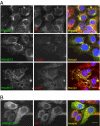rnaset2 mutant zebrafish model familial cystic leukoencephalopathy and reveal a role for RNase T2 in degrading ribosomal RNA
- PMID: 21199949
- PMCID: PMC3024650
- DOI: 10.1073/pnas.1009811107
rnaset2 mutant zebrafish model familial cystic leukoencephalopathy and reveal a role for RNase T2 in degrading ribosomal RNA
Abstract
T2-family acidic endoribonucleases are represented in all genomes. A physiological role for RNase T2 has yet to be defined for metazoa. RNASET2 mutation in humans is linked with a leukoencephalopathy that arises in infancy characterized by cortical cysts and multifocal white matter lesions. We now show localization of RNASET2 within lysosomes. Further, we demonstrate that loss of rnaset2 in mutant zebrafish results in accumulation of undigested rRNA within lysosomes within neurons of the brain. Further, by using high field intensity magnetic resonance microimaging, we reveal white matter lesions in these animals comparable to those observed in RNASET2-deficient infants. This correlates with accumulation of Amyloid precursor protein and astrocytes at sites of neurodegeneration. Thus we conclude that familial cystic leukoencephalopathy is a lysosomal storage disorder in which rRNA is the best candidate for the noxious storage material.
Conflict of interest statement
The authors declare no conflict of interest.
Figures




References
-
- Henneke M, et al. RNASET2-deficient cystic leukoencephalopathy resembles congenital cytomegalovirus brain infection. Nat Genet. 2009;41:773–775. - PubMed
-
- Campomenosi P, et al. Characterization of RNASET2, the first human member of the Rh/T2/S family of glycoproteins. Arch Biochem Biophys. 2006;449:17–26. - PubMed
-
- Ballabio A, Gieselmann V. Lysosomal disorders: From storage to cellular damage. Biochim Biophys Acta. 2009;1793:684–696. - PubMed
Publication types
MeSH terms
Substances
Grants and funding
LinkOut - more resources
Full Text Sources
Other Literature Sources
Molecular Biology Databases

